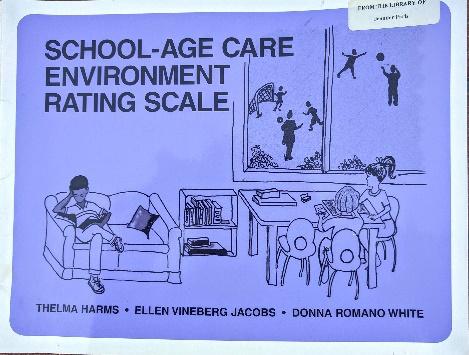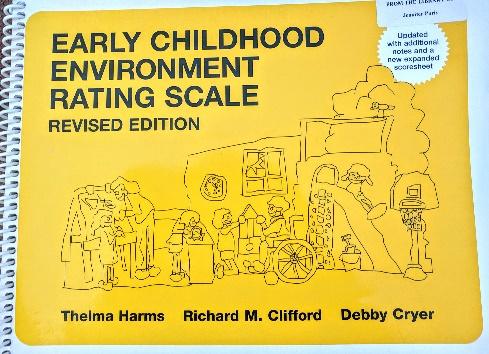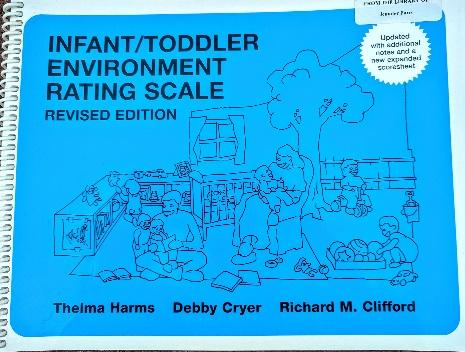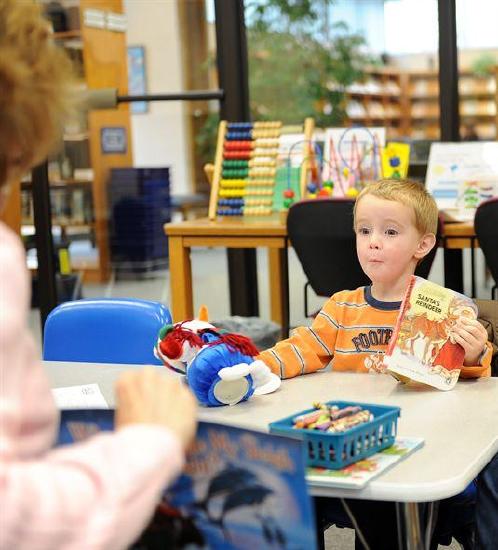2.8: Measuring High-Quality in Early Care and Education Classrooms
- Last updated
- Save as PDF
- Page ID
- 42514

- Gina Peterson and Emily Elam
- College of the Canyons
One of the characteristics of a high-quality early childhood program is the practice of continuously monitoring children’s development, along with the environmental setting and teacher interactions. By evaluating the overall performance in these key areas, teachers, administrators and families can reflect, make necessary changes and improvements to support all students and families. There are numerous tools on the market that evaluate program quality. For the purpose of this text we will focus on just a few tools that are highly recognized and most often used in California to monitor quality practices in preschool programs.
The Environment Rating Scales (ERS)
The Environment Rating Scale is a standardized assessment tool that can help caregivers, teachers, and administrators improve the quality of their program. The ERS measure process quality .
Process quality consists of the various interactions that go on in a classroom between staff and children, staff, parents, and other adults, among the children themselves, and the interactions children have with the many materials and activities in the environment, as well as those features, such as space, schedule and materials that support these interactions. Process quality is assessed primarily through observation and has been found to be more predictive of child outcomes than structural indicators such as staff to child ratio, group size, cost of care, and even type of care, for example child care center or family child care home . [11]
There are 4 Environment Rating Scales:
- The Infant and Toddler Environmental Rating Scale (ITERS) for programs serving young learners aged 6 weeks to 30 months
- The Early Childhood Environmental Rating Scale (ECERS) for preschool programs serving children aged 3-5 years
- The School-Age Child Environmental Rating Scale (SACERS) for afterschool programs serving children aged 5-12 years
- The Family Child Care Environmental Rating Scale (FCCERS) for family childcare programs serving children aged 6 weeks to 12 years.



Why Use Environment Rating Scales
The scales are used in a variety of ways including for self-assessment by center staff, preparation for accreditation, and voluntary improvement efforts by licensing or other agencies. For example, in the United States:
- Several states, including California , Massachusetts, Montana, Mississippi, Kansas, Oregon, Kentucky, New Mexico, Georgia, Florida, Wisconsin, and Nebraska have also initiated quality evaluation and improvement programs using our scales. Each state is tailoring its use of the scales to its individual needs and resources.
- The state of Arkansas has trained personnel, who do assessments and provide training and technical assistance so that childcare centers and homes can increase their quality of care. Another innovative feature of the Arkansas program is that parents who select childcare facilities with an average of 4.5 or higher on our scales are eligible for two times the state childcare tax exemption. Thus, both parents and providers are being rewarded for quality improvements that benefit the children.
- The state of Colorado uses the scales in a variety of program improvement and evaluation projects. For example, Denver has a quality improvement program that uses on site consultation and training based on scale scores. Many of the centers participating in this program serve poor and minority children and their families. The state of Colorado is currently considering a tiered reimbursement system using the scales.
- North Carolina also currently uses scale scores as part of their 5-star rated license system. Centers and family childcare homes are awarded either one or two stars based on compliance with licensing standards. Programs may voluntarily apply for an additional three stars based on a set of quality measures including the licensing compliance record, teacher and director education, and the levels of process quality as measured by the appropriate environmental scale. Only the lowest level of licensing is mandatory. However, an additional fee is paid to the provider of subsidized care for each additional star earned voluntarily.
- The Oklahoma 3-star tiered license incorporates an evaluation with the scales in the second tier as a basis for quality improvement, and provides technical assistance based on scores for meeting accreditation standards. Tiered reimbursement is a part of this system.
- Tennessee is now initiating a rated license system, based on North Carolina's experience. In their system, however, program evaluation is not voluntary, but is required yearly to create a "Report Card" that must be posted with the license so childcare consumers have access to reliable information on the quality of childcare they are using for their children. Tiered reimbursement will also be tied to scores on the scale.
- All the US military services have been using the scales routinely in their center and family childcare homes for program improvement and monitoring. The military child development system was recognized by Executive Order in 1998 for its high quality.
- Our environmental rating scales are widely used by programs as they prepare for accreditation . This is due to the fact that our scales use a format with detailed levels of quality that provides a blueprint for gradual change. The content of our scales is completely supportive of the various credentialing and accreditation programs.
The ERS Tool
As suggested by ERS, in order to provide high-quality care and education experiences to all children and their families, a childcare program must provide for the three basic needs all children have:
- Protection of their health and safety
- Building positive relationships
- Opportunities for stimulation and learning from experience
Let’s take a closer look at how to use the Early Childhood Environmental Rating Scale (ECERS-3) for preschool programs serving children aged 3-5 years. The Scale consists of 35 items organized into 6 subscales: [13]
- Space and Furnishings
- Personal Care Routines
- Language and Literacy
- Learning Activities
- Interaction
- Program Structure
Within each subscale there are indicators that are arranged in a hierarchical order with basic needs at low levels and the more educational and interactional aspects at higher levels. The requirements for each indicator must be met before the next indicator is measured. If a requirement is not met, scoring then comes to a stop.
Scoring:
- 1 = inadequate
- 3 = minimal
- 5 = good
- 7 = excellent
Empirical Research
Empirical studies using the Early Childhood Environment Rating Scale – Revised (ECERS-R) tool have generally found positive associations between the quality of early childhood programs and child development.
The ECERS-R (1998) is the revised edition of the original ECERS (1980). It is currently being used in several major studies, including the Early Head Start Study (Mathematica Corporation), and Welfare, Children and Families: A Three City Study (Columbia University, University of Chicago, and Harvard University). The original ECERS was used in the Head Start FACES study, in which over 400 classrooms are included nationwide. The preliminary results in all these studies show that the ECERS and the ECERS-R are performing very well.
Additionally, it should be noted that the ECERS and ITERS were used as the comprehensive quality measures in the National Child Care Staffing Study (Whitebook, Howes, & Phillips, 1989) and the Cost, Quality, and Child Outcomes Study (1995), the major studies of their time. The FDCRS was used in The Study of Children in Family Child Care and Relative Care (Galinsky, Howes, Kontos, & Shinn, 1994). In all of these studies, a relationship was found between higher scores on the ECERS and more positive child development outcomes in areas that are considered important for later school success. The effects of higher quality early childhood experiences have now been shown to last at least through the second grade of elementary school (Peisner-Feinberg, Burchinal, Clifford, Culkin, Howes, Kagan, Yazejian, Byler, Rustici, & Zelazo, 1999). Research is continuing to evaluate longer-lasting effects. [14]
ERS Strengths
The instrument has good test-retest reliability, high inter-rater reliability (Clifford et al., 2010), and many studies have demonstrated its predictive validity (Burchinal et al., 2008; Montes et al., 2005; Peisner-Feinberg et al., 2001). Furthermore, the results show that ECERS-R is a significant predictor of child development in two domains: physical health and well-being, and social competence.
ERS Limitation
While the ECERS-R is a useful tool to measure the quality of early childhood programs across various settings, there are some limitations. Because the Environmental Rating Scales were developed in the United States, the relevance to non-American cultural settings has been questioned (Dickinson,2006; Mathers, Singler,& Karemaker, 2012). Some have criticized that the ITERS-R scale places too much emphasis on the structural aspects of childcare (Sanders & Howes, 2013;Vermeer et al., 2008, while others are concerned that the Rating Scales fail to measure the interactions between the teacher and children and families, which is considered to be key quality factors in childcare (Bisceglia, Perlman, Schaack,& Jenkins, 2009; Helmerhorst et al., 2014).
Although the Environment Rating Scales are highly regarded, there has also been some considerable criticism. For example, a closer look at the items in the ECERS-R reveals that some items may be less relevant than others in our study’s setting—poor, rural villages in Indonesia. Item 27 outlines the provision of TV, video or computers for classroom activities. Item 3 describes the provision of soft furnishings such as carpeted space and cushions for children’s relaxation and comfort. While all of these provisions would be great to have, they are often unfeasible in rural, resource-constrained environments. In over 3 weeks of field observation, we rarely saw soft furnishings—sitting on the floor for children and adults alike is the norm in rural Indonesia – even when soft furnishings are available. We did encounter one center with a computer lab during piloting of the ECERS-R but this was a state-of- the-art center where not one but three international donors had channeled funding. [15]
ECERS FAQ Find:
- When was the first ECERS tool published?
- Who typically uses the ECERS tool?
- Who administers the assessment tool?
- How can teachers prepare for an assessment?
- When was the last time the ECERS tool was updated?
- How many measures are there in the ECERS?
The Classroom Assessment Scoring System (CLASS)
Research shows that all children benefit from high-quality instruction and classroom interactions, regardless of language status, race/ethnicity, or special needs (August & Shanahan, 2006; Bowman, Donovan, & Burns, 2001). When teachers provide individualized support and guidance to the children in their classrooms, they contribute to each child’s social and emotional development, which has been linked to their overall physical development and academic achievement. The CLASS tool showcases various strategies that teachers can implement to promote quality interactions. It is important to note that class does not favor any curriculum model over another.
The CLASS tool differs from other measurement tools that may address the content of the physical environment, available materials, or a specific curriculum. Although the physical environment materials and curriculum are important, the CLASS tool focuses more on the context of how teachers directly interact, engage and communicate with the children in their classroom environment. CLASS measures cooperative and creative learning experiences and focuses on the teacher’s role in allowing children to be active participants in their own learning. More specifically, CLASS promotes social justice and equity, and has “indicators” to assess how a teacher develops a sense of community and empathy for others. Not only must the teacher consider the tangible environmental elements, they must consciously incorporate quality interactions. Teachers must ask questions and engage in thoughtful conversations that emphasize back and forth dialogue rather than one and done responses. Teachers must extend the children’s vocabulary and create opportunities where children can use their expressive language skills. Lastly, teachers must provide positive feedback to children throughout the day and allow children to make choices.
Why Use the Classroom Assessment Scoring System (CLASS)
As advocates and educators, we know that engaging interactions and well-designed environments form the foundation for optimal learning to occur. High-quality preschool programs should strive to incorporate the following:
- well-managed and well-organized classrooms with clearly defined spaces
- support systems to enhance children’s social and emotional development
- a variety of instructional materials that stimulate children’s thinking and curiosity
- opportunities for authentic interactions and meaningful conversations
- a balance of teacher-directed activities and child-directed activities
- enhanced language and literacy implemented throughout the day
- opportunities for movement and classroom spaces that support kinesthetic learning
Research findings from over 3,000 classrooms found that children who were in classrooms that received higher CLASS ratings showed greater gains in social skill, language, early literacy, and math development. Furthermore, after a decade of research, crucial conclusions were made that suggest using the CLASS tool can not only improve the effectiveness of an individual classroom, it can also improve the program as well. Let’s look at some reasons as to why you might want to use the CLASS tool:
- Effective teacher–child interactions are an active and crucial ingredient for children’s social and academic development.
- Children in ECE settings are not consistently exposed to effective teacher–child interactions.
- Initial evidence suggests thresholds for effective teacher–child interactions, as measured by CLASS, in promoting children’s learning and development.
- Quality improvement efforts that focus explicitly on teacher–child interactions maximize impacts for children.
- Carefully designed and implemented professional development support can improve the quality of teacher–child interactions
The CLASS Tool
The CLASS Tool is divided into 3 Domains: Emotional Support; Classroom Organization; and Instructional Support. Each Domain has several Dimensions (see the chart below), and each Dimension has several Indicators that provide detailed descriptors of how a teacher should interact (Note: the indicators for each dimension are not listed in the chart below.)
|
Emotional Support |
Classroom Organization |
Instructional Support |
|---|---|---|
|
|
|
Scoring
Scoring is based on a 7-point scale, with the “low range” being a score of 1 to 2, the “middle range” a score of 3 to 5, and the “high range” a score of 6 to 7. The higher the range in each dimension the better.
CLASS Strengths
The Classroom Assessment Scoring System (CLASS) tool is a systematic observation tool that can be used to measure the interactions between teachers and their children in typical classroom settings. The CLASS tool has also been used to assess classroom quality across diverse populations, including dual language learners (DLLs), children from migrant families, tribal populations, in addition to children with special needs and children with diverse cultural backgrounds (Downer et al., 2011). The CLASS tool is deemed both reliable and valid, and it provides preschool programs and individual classroom teachers with an opportunity to regularly monitor and evaluate themselves.
Formal assessments can be made by certified CLASS evaluators and the results are shared with the teacher and program with the intent of finding strategies on how to improve interactions. The tool can also be used informally. Teachers can review each domain, dimension and indicator, and then reflect on their own practices to find ways they can incorporate more intentional interactions.
CLASS Limitations
Even though every CLASS observer is formally certified, there will be small, systematic differences in their scoring. Some observers may tend to give slightly higher scores, while others may tend to be slightly more critical. Although slight differences fall within the threshold for “reliability,” inaccurate results have been noted. One other limitation is that there is little emphasis on structural quality . More specifically, CLASS does not assess the physical environment or materials, and it is not designed to review program safety.
Additional Methods, Tools and Techniques to Ensure High-Quality Practices
Program Accreditation
Both the National Association for the Education of Young Children (NAEYC) (link: https://www.naeyc.org/ ) and the National Early Childhood Program Accreditation (NECPA) [16] (link: https://www.naeyc.org/accreditation ) are nationally recognized agencies that set a standard of excellence for overall program quality. Programs that pursue accreditation must meet key criteria expectations in areas such as “the learning environment, teacher and child interactions, staff qualifications, professional development, and family engagement” (Center for America, 2017, p. 6). Both NAEYC and NECPA offer training, technical assistance, and consulting services to support early care and education programs that not only want to meet but exceed standard industry practices. Accreditation is a voluntary endeavor that requires programs to undergo a self-study as they prepare for the validation process. Programs that achieve accreditation status must be re-assessed every three years to demonstrate a continued commitment to high-quality practices.
The Quality Rating and Improvement System (QRIS)
The Quality Rating and Improvement System (QRIS) is a systemic approach to assess, improve, and communicate the level of quality in early care and school-age care programs. [17] The main purpose of the QRIS is to improve and standardize the quality of care in all facilities in the state, and to make childcare more accessible and affordable for families. In California, the QRIS is used to:
- Assess program quality comparably across provider types (publicly and privately funded, centers and family childcare homes) throughout the state
- Align program standards with early learning and practitioner standards
- Support continuous quality improvement for participating programs and their staff
- Provide families with information about program quality to assist them in making informed choices . [18]
The Caregiver Interaction Scale (CIS)
In the late 80’s, Arnett released the Caregiver Interaction Scale (1989) to assess a global rating of caregiver sensitivity and responsiveness in both early care and education settings and family childcare environments. The tool focuses on caregiver / teacher emotional interactions and measures several items including sensitivity, harshness, detachment, and permissiveness. Items are rated on a 4-point scale. The scale has limitations as it captures only one aspect of process quality, and thus it is suggested that additional assessments be used to measure more structural dimensions.
NAEYC Position Statement on Importance of Environmental Assessments[19]
The National Association for the Education of Young Children and the National Association of Early Childhood Specialists in State Departments of Education take the position that policy makers, the early childhood profession, and other stakeholders in young children’s lives have a shared responsibility to:
- Construct comprehensive systems of curriculum, assessment, and program evaluation guided by sound early childhood practices, effective early learning standards and program standards, and a set of core principles and values: belief in civic and democratic values; commitment to ethical behavior on behalf of children; use of important goals as guides to action; coordinated systems; support for children as individuals and members of families, cultures, and communities; partnerships with families; respect for evidence; and shared accountability.
- Implement curriculum that is thoughtfully planned, challenging, engaging, developmentally appropriate, culturally and linguistically responsive, comprehensive, and likely to promote positive outcomes for all young children.
- Make ethical, appropriate, valid, and reliable assessment a central part of all early childhood programs. To assess young children’s strengths, progress, and needs, use assessment methods that are developmentally appropriate, culturally and linguistically responsive, tied to children’s daily activities, supported by Professional development, inclusive of families, and connected to specific, beneficial purposes: (1) making sound decisions about teaching and learning, (2) identifying significant concerns that may require focused intervention for individual children, and (3) helping programs improve their educational and developmental interventions.
- Regularly engage in program evaluation guided by program goals and using varied, appropriate, conceptually and technically sound evidence to determine the extent to which programs meet the expected standards of quality and to examine intended as well as unintended results.
- Provide the support, Professional development, and other resources to allow staff in early childhood programs to implement high-quality curriculum, assessment, and program evaluation practices and to connect those practices with well-defined early learning standards and program standards.


